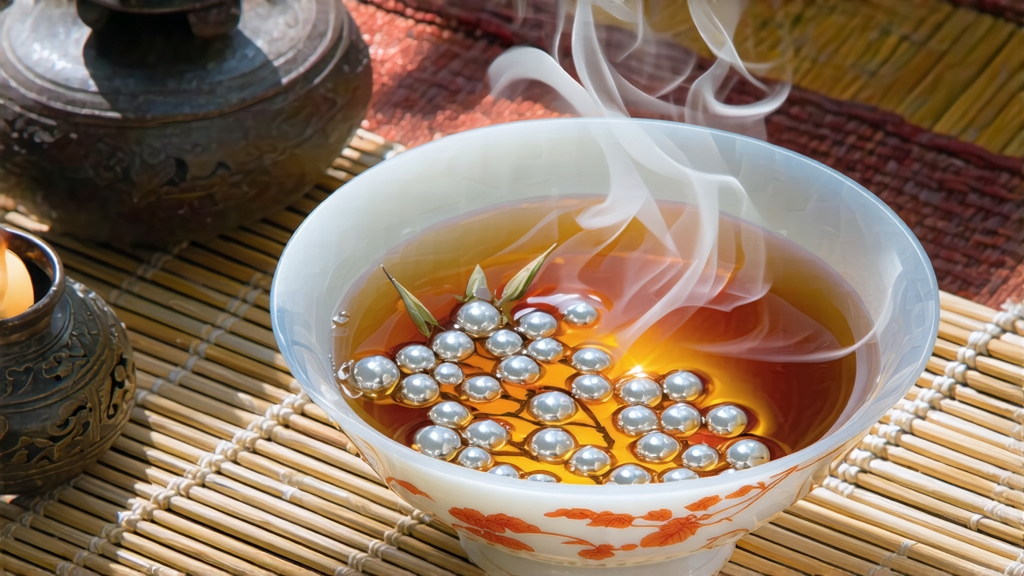
Among the six classical families of Chinese tea, white tea is the least theatrical yet the most elusive; it is oxidised by time and air rather than by fire or hand. Within this family, Bai Hao Yin Zhen—literally “White-Hair Silver Needle”—sits at the apex, the single-bud expression that connoisseurs call “the moonlight of tea.” To international drinkers accustomed to the smoky drama of Lapsang or the grassy snap of sencha, Silver Needle can feel almost too quiet, a liquor that whispers instead of sings. Yet once its subtleties are decoded, the tea becomes a compass for understanding the Chinese aesthetic of restraint, where what is withheld is often more eloquent than what is displayed.
Historical records first mention “white tea” during the Song dynasty (960-1279), but those cakes were green teas whose downy buds merely appeared white. True Silver Needle, made solely from unopened buds, was not documented until the late eighteenth century in Fuding county, Fujian province. Local legend credits a tea-grower named Wei Zhen for hiding buds in his sleeve while fleeing bandits; the next morning the buds had blanched and emitted an aroma so delicate that he replicated the accidental withering and presented the tea to the magistrate. Whether myth or marketing, the story captures the tea’s founding principle: minimal intervention, maximum patience. By the 1890s, Silver Needle had become a tribute tea shipped down the Min River to foreign treaty ports, where European merchants mis-labelled it “Pekoe Tips,” a name still found on dusty tins in London antique shops.
Botanically, only two cultivars are authorised for authentic Silver Needle: Fuding Da Bai (Big White) and Zhenghe Da Bai. The former yields fatter buds with 5-7 % amino acids, giving a creamier texture; the latter produces slimmer, more aromatic buds with higher catechin content and a cooler, mineral finish. A single kilogram of Silver Needle contains roughly thirty-eight thousand buds, all plucked within a March window when the bud is sheathed but not yet splayed. Experienced pickers use a “twist-and-lift” motion that avoids the fingernail’s oxidising pressure; buds are dropped into wicker baskets lined with banana leaf to prevent bruising. Because the tea is never rolled, every downy hair remains intact, scattering light like frost on a winter lawn.
Processing is disarmingly simple yet unforgiving. The buds are spread on bamboo trays called shaiqing and left to wither for thirty-six to sixty hours, depending on humidity. No ovens, no tumblers, no charcoal—only moving air and the gradual evaporation of cellular moisture. Master witherers speak of “listening to the bud,” a meditative practice that involves touching the tea every hour to gauge the transition from springy to leathery. When the moisture content drops to 8-10 %, the buds are transferred to a low-temperature dryer (never above 40 °C) to halt enzymatic activity while preserving the silver down. The entire cycle must finish before the spring rain front arrives; one untimely shower can oxidise the tips into a dull grey, reducing market value by half. Finished Silver Needle displays a tri-colour spectrum: platinum tips, celadon shafts, and a faint blush called “peach light” that signals perfect withering.
Western brewing guides often recommend 80 °C water for three minutes, a protocol that flattens the tea into a wan vegetable broth. A more faithful approach is the gongfu ritual designed for contemplation rather than consolation. Begin by pre-warming a tall glass gaiwan; the transparency allows you to watch buds stand upright like miniature obelisks. Use 3 g of tea per 120 ml and water just off the boil (95 °C). The first infusion, fifteen seconds, releases a pale chartreuse liquor with aromas of fresh alfalfa and steamed rice. By the third steep, the temperature has cooled to 85 °C and the cup presents notes of honeydew, white truffle, and the elusive “bamboo rain” fragrance that Chinese poets liken to the smell of a mountain path after drizzle. Silver Needle is famously durable; seven steeps is common, twelve is possible if the picker included a proportion of “dragon-eye” buds—those spherical tips that resemble the fruit’s pupil